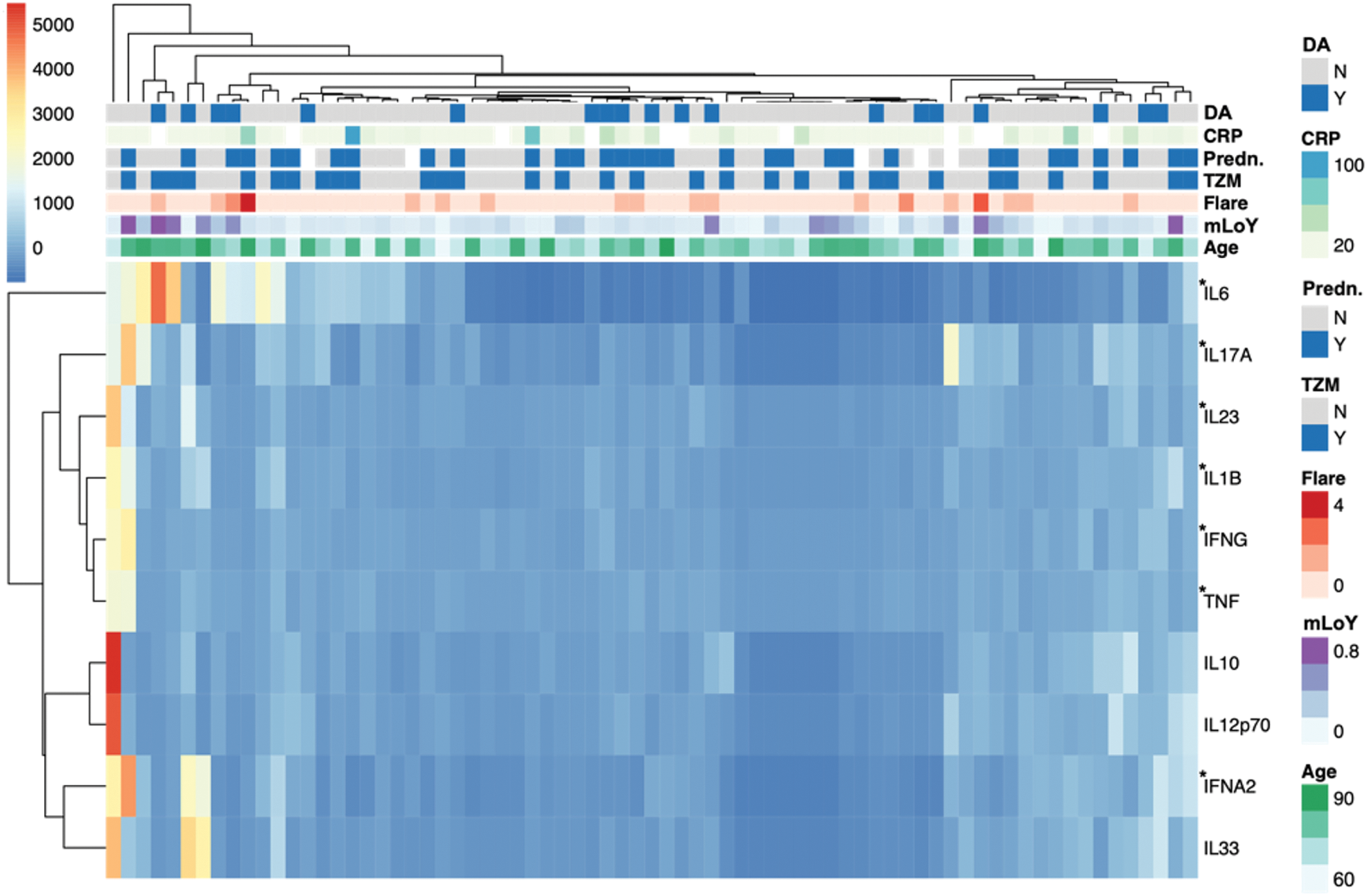

Background: Mosaic loss of the Y chromosome (mLOY) in leukocytes is the most common acquired somatic mutation in aging men. Recent studies have highlighted its functional impact with upregulation of gene expression, particularly in MAPK signaling pathways. This fosters apoptosis resistance, oncogenesis, metabolic disturbances, enhanced inflammation via NF-κB activation, and excessive extracellular matrix proliferation and fibrosis through TGFβ/SMAD2 signaling. Consequently, mLOY may contribute to the pathogenesis of age-related autoimmune diseases. Giant cell arteritis (GCA), predominantly affecting individuals over 50, emerges as a promising target for further investigation.
Objectives: To investigate the role of mLOY on disease activity, relapse risk, and its pathophysiological role in GCA.
Methods: Patients with GCA were recruited for a cross-sectional study. Demographic, medical history, and clinical data were collected. Analysis of mLOY was performed using digital droplet PCR (ddPCR) with a single nucleotide polymorphism (SNP) assay differentiating AMELX and AMELY (Thermo Fisher Scientific). To determine the optimal mLOY cut-off for predicting relapses, a receiver operating characteristic (ROC) curve and the Youden index were calculated. Relapse-free survival was analyzed using Kaplan-Meier analysis (log-rank test). Multivariate Cox regression analyses were conducted to adjust for potential confounders. Proinflammatory cytokines were measured using the LEGENDplex™ Human Inflammation Panel 1 (BioLegend), assessing IL1β, IFNα2, IFNγ, TNFα, MCP1, IL6, CXCL8, IL8, IL10, IL12p70, IL17A, IL18, IL23, and IL33.
Results: A total of 74 GCA patients (mean age 76.0 years, SD±10.7) were included. Of these, 25.7% (19/74) had active disease, and 41.9% (31/74) were treated with tocilizumab. Relapse was documented in 24.3% (18/74) of patients. The median mLOY level was 17.8% (SD±23.7). A cut-off value of 10.2% mLOY was identified as optimal for predicting relapse (p<0.001), with 32.4% (24/74) of patients exceeding this threshold. After adjusting for age, mLOY >10.2% remained an independent predictor of relapse risk (HR: 14.2; 95% CI: 3.0–67.2; p<0.001) (Figure 1). During remission, patients with mLOY >10% exhibited significantly higher IL6 levels compared to mLOY-negative patients (p=0.039). As a continuous variable, mLOY was positively associated with IL6 (p=0.001, r=0.43) and IL17A (p=0.031, r=0.29). This effect was particularly pronounced in remission patients receiving tocilizumab. In this subgroup, mLOY significantly correlated with IL1β (p=0.041, r=0.37), IFNγ (p=0.005, r=0.49), TNFα (p=0.009, r=0.46), IL6 (p<0.001, r=0.75), and IL17A (p=0.003, r=0.52) (Figure 2).
Predictive Value of mLoY for Relapse in GCA Patients and Survival Analysis.
Figure 1 illustrates the predictive role of mLoY in assessing relapse risk among patients with GCA. ROC curve identifying the optimal mLOY cut-off value of 10.2% for predicting relapse in GCA patients (p<0.001). B: Kaplan-Meier analysis of relapse-free survival stratified by mLOY status, showing significantly reduced relapse free survival in patients with mLOY >10.2% (p<0.001). C: Multivariable Cox regression confirming mLOY >10.2% as an independent predictor of relapse risk after adjusting for age (HR: 14.2; 95% CI: 3.0–67.2; p<0.001). Abbreviations: mLoY = mosaic loss of Y chromosome, GCA = giant cell arteritis, HR = hazard ratio, CI = confidence interval. * = p<0.05 indicates statistical significance.

Association of Inflammatory Cytokine Profile, mLoY, and Clinical Parameters in GCA Patients.
Figure 2 demonstrates the association between the expression of selected pro-inflammatory cytokines, mLoY, and clinical parameters in patients with GCA. When analyzing mLoY as a continuous variable, a positive correlation was observed between mLoY and the cytokines IL6, IL1 β , IL17A, IFN- γ , and TNF- α in patients in remission under tocilizumab therapy. Abbreviations: DA = disease activity, Predn. = prednisolone, TZM = tocilizumab, mLoY = mosaic loss of Y chromosome. * = p<0.05 indicates statistical significance.

Conclusion: This study is the first to demonstrate that mLOY serves as an independent predictor of relapse risk in GCA patients and is associated with modulation of proinflammatory signaling pathways in patients in remission. This effect was particularly evident under tocilizumab therapy. Our findings highlight the potential of mLOY as a prognostic biomarker and underscore its possible role in the pathophysiology of GCA.
REFERENCES: NIL.
Acknowledgements: NIL.
Disclosure of Interests: None declared.
© The Authors 2025. This abstract is an open access article published in Annals of Rheumatic Diseases under the CC BY-NC-ND license (